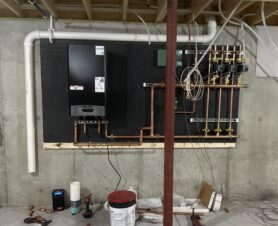Sustainability in building systems has become a trending topic in the past several years. Although equipment with a higher level of efficiency and overall sustainability tends to cost more to produce and install, interest continues to grow. Property owners want the assurance of knowing that their systems can handle changes in the availability of energy and interruptions to the power grid, while still providing excellent indoor comfort. These trends highlight the ongoing development of sustainable HVAC technology for residential, commercial and industrial customers.

Efficient HVAC Systems
A push toward greater efficiency makes sense in terms of sustainability and lower carbon emissions. Efficient systems, with proper installation and routine maintenance, can significantly reduce the energy consumption for the same amount of cooling or heating output. To accommodate the need for more effective HVAC systems, the U.S. Department of Energy set new standards in 2023 for the minimum efficiency of certain types of HVAC equipment. New systems with cooling capability must meet a minimum seasonal energy efficiency ratio of 14 or 15, depending on region. Heat pumps must also follow a minimum heating seasonal performance factor of 8.8.
Sustainable Energy Sources
As worry about the availability of fossil fuels increases, manufacturers look for ways to decrease their dependence on these fuels. In the past decade, technological advances allowed consumers and businesses to implement sustainable HVAC solutions, such as geothermal heat pumps. Innovation continues as the market adds and refines options. Hydronic systems rely on systems of water to extract heat for indoor heating, water heating, and other purposes, conserving the water for use. Solar thermal systems allow for the large-scale production of electricity — enough for applications in residential, commercial and industrial sectors.
Tools to Improve Indoor Air Quality
Ventilation is one of the most important aspects of heating and cooling systems, and recent advancements can make ventilation easier and more effective. The COVID-19 pandemic and the rise in the number of wildfires highlighted the importance of indoor air quality, which is often worse than the air outside. New systems can accommodate a variety of additional features, including UV bulbs, antimicrobial air filters and other types of air purification systems. HVAC technicians installing a series of these air cleaning options can help to improve the indoor air quality without compromising air flow or efficiency.
Smart Technology
Smart technology allows residences and businesses to maximize comfort while working on decreasing energy consumption and improving energy efficiency. Automated systems simplify the process of managing a commercial building, with the ability to seamlessly integrate HVAC into lighting, security, and other systems. Smart technology continues to improve in ways that decrease the need for human attention. Advanced sensors can help users monitor the temperature, humidity and air quality of various parts of the building, as well as locating problems and identifying the best times for heating and cooling maintenance.
Self-Cleaning HVAC Systems
Although professional maintenance twice a year offers the best case for long-term equipment efficiency, the time between those visits can wreak havoc on a system. Dirty equipment leads to lower efficiency, drops in performance and system breakdowns. The latest technology incorporates some elements of self-maintenance, so that users can provide ideal protection for their systems between maintenance services. For example, HVAC systems need to be kept clean and dry for proper operation. A self-cleaning function for an air conditioning unit might focus on drying each component, to prevent water buildup, icing and dust accumulation.
The rising cost of fuel, coupled with potential interruptions to the power grid, turns people’s heads to the possibilities of renewable energy technology. New HVAC systems can rely on heat and energy sources that allow property owners to minimize their dependence on fossil fuels or an overworked power grid. These technologies provide other benefits, including decreasing energy consumption, lowering carbon emissions and improving indoor air quality.
 Author bio: Leslie Erickson is the Marketing Manager at Air Mechanical. She has been working for Air Mechanical for most of her life and specializes in marketing. She is dedicated to bringing customers the best experience possible for their family and their homes.
Author bio: Leslie Erickson is the Marketing Manager at Air Mechanical. She has been working for Air Mechanical for most of her life and specializes in marketing. She is dedicated to bringing customers the best experience possible for their family and their homes.
SOURCES
https://www.eia.gov/todayinenergy/detail.php?id=40232
Sustainable HVAC Trends: What Clients are Asking for in 2024
Smart Tech & Innovations for Sustainability in the Future of HVAC
https://www.grainger.com/know-how/operations/facility/kh-hvac-evolving-for-sustainability
https://www.eia.gov/todayinenergy/detail.php?id=40232




Join the conversation: